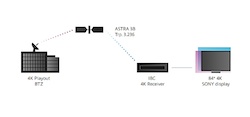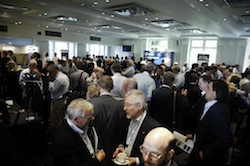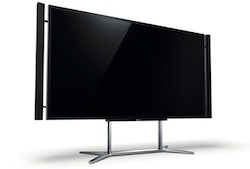
The surprising near-term viability of higher than HD resolution broadcasting dominated the tech talk at trade event IBC. Broadcasters are set to begin tests with the first full 4K services expected within three years. “With IFA followed by IBC there has been a mental shift in the attitude of broadcasters who suddenly see a strong future for 4K into the home,” said Olivier Bovis, Sony’s Head of AV Media. “Several [broadcasters] say they plan to experiment and test 4K in sports and other events. Before IBC I would have said that 4K broadcasts were still many years away. Now, with the considerable interest we’ve seen, I would say full 4K services will be arriving in 2-3 years.” Ultra-HD (U-HD) the high-resolution format shortly to be ratified as an international standard, can be either four (4K) or sixteen (8K) times the pixel count of HD 1080p. The latter has been pioneered as Super Hi-Vision by Japan’s NHK and its plans include SHV broadcasts timed for the Rio Olympics 2016. However the U-HD format also accounts for the lower 4K resolution and it is this to which all the elements of a workable broadcast chain are aligning. In support of existing 4K cameras from Red, For-A, Canon, JVC and Sony there is a burgeoning range of post processing tools and a rash of encoders tuned to compress video using HEVC (Higher Efficiency Video Codec), a scheme which is twice as efficient at squeezing video than MPEG4. That’s important to satellite operators who suddenly have a whole new reason to sell transponder space and can use HEVC to beam 4K direct to home. Once there, we can all view the sharper images on LCD displays such as those mushrooming at consumer electronics show IFA days before IBC from Sony, Toshiba, LG, Panasonic, Hisense, Haier and more. “When HEVC comes available next year we will be able to reduce the bitrate from 50Mbps to 20Mbps, which is similar to HDTV over MPEG2 in 2000, making it commercially viable for broadcasters,” explained Thomas Wrede, VP, Reception Systems at satellite operator SES, which demonstrated a live 4K feed at IBC to the Sony stand from one its Astra satellites. Satellite rival Eutelsat also showed a 4K feed beamed to a Mitsubishi 4K LCD TV at IBC. “U-HD is what the consumer expects as the next step in home delivery,” added Wrede. “We have the whole chain now and we are going to bring 4K into the home much sooner than many people think.” Sky Deutschland aims to be one of the first, telling the IBC Daily that it had a U-HD project up and running. “I first saw a demo about six years ago when the camera was about the size of a small car, and I was totally captivated,” said Brian Sullivan, CEO, Sky Deutschland. “It makes sense for pay TV to showcase this technology in the first instance.” On the production side, 4K is established in cinema and high end TV drama, but as Bovis noted: “manufacturers have to build a wider range of broadcast cameras and tools for live production in 4K.” A 4K-ready broadcast camera (NEX-FS7000) announced by Sony at NAB is still awaiting a recorder for its 4K capability to be activated, while Canon showed 4K recording for its upcoming EOS-C500 camcorder using external recorders from both Codex and AJA. Visitors could also view a demonstration of 4K being used for HD production on the Sony booth, with two 4K F65 cameras paired together on a stadium gantry while the dual 4K output was stitched together to allow an operator to extract or scale pristine HD images from a portion of the 4K frame during a live transmission. Video processing specialist AJA debuted the Corvid Ultra, a new I/O card, that did a similar trick. “Everyone is trying to figure out how to make 4K workable and manageable,” said AJA product marketing manager, Bryce Button. “Broadcasters cannot broadcast 4K today but they are really interested in using 4K cameras within the HD workflow.” One controversial question at IBC was quite where all the attention on U-HD was leaving the previous saviour of the consumer electronics industry, 3D. With investment in both camps, Sony saw the best of all sides. “4K is also positive for the 3D story since a full 4K delivered image would deliver full HD to both eyes of a passive glasses viewing system which Sony has long believed is the superior stereoscopic experience in the home,” said Bovis. – Adrian Pennington







